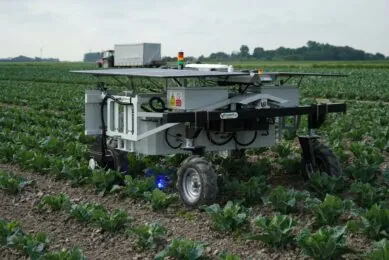Concentrated light to weed better than other technologies

Earth Rover, a British/Spanish startup is working on three different field robots including its Terrier rover for selective weeding with concentrated light.
The British/Spanish startup Earth Rover is developing three different types of field robots that are all based on the same vehicle platform. The Retriever field robot will be able to select and only harvest vegetables of a predetermined size, while robot Pointer is intended to scan every plant to count, measure, map and monitor its growth and health. Terrier on the other hand, is being developed for selective weeding with concentrated light and expected to be commercially available in 2023.
During the recent World FIRA ag robotics Forum, Earth Rover’s CTO Ricard Pardell explained why he feels that their concentrated light technology is more effective for weeding compared to mechanical and laser weeding technology.
Text continues underneath video
Solid-state light emitting diodes
Earth Rover uses solid-state light emitting diodes to eliminate weeds. A lens is used to concentrate the light of the single diodes. Although currently nothing more than a black or rather a white box, Pardell refers to the technology as Concentrated Light Autonomous Weeding and Scouting (CLAWS).
The existing box contains four robots, 4 concentrated light units, each with 3 degrees of freedom to focus on weeds detected by a stereo camera. Once detected, weeds are eliminated by short pulses of light aimed at the meristem of the plant. This operation is performed step by step and this means that, at least at the moment, the weeding rover has to stop to emit light at the targeted weeds. Once stopped, the box with the light units can process an area of 1.6 m wide and 1.0 m long. This way, the current speed is 20 weeds per second.
After dealing with the weeds, the rover starts driving again until the next weeds are detected by the stereo camera at the front of the vehicle. The power consumption is 10 joules per weed. With an efficiency of the diodes of 40%, the gross power consumption amounts to 18 to 20 joules per weed. This typically comes down to 800 joules/m2, Pardell explained. He expects the weeding rover to have a capacity of 2 to 3 hectares per day (of 8 hours) while the system is also capable of working at night.
Text continues underneath image

Collecting and valuing crop data
Although robot Pointer is being developed alongside robot Terrier to scan every plant to count, measure, map and monitor its growth and health, the stereo camera mounted on the 150 kg Terrier weeding rover also gathers crop data such as plant positions and sizes. The stereo camera mounted in the front of the rover constructs a plant map on the go and there are more sensors to come. In its business proposition, Earth Rover actually values the gathering of these crop data at € 250 per hectare per year.
The (financial) benefits
Pardell: “We believe that our technology is not only more effective but also less harmful for plant, soil and operators. Compared to mechanical weeding, we don’t disturb the soil and are able to weed close to each plant without any crop damage. Not disturbing the soil means no CO2-emission, no effect on soil moisture and we don’t create a seed bed. Compared to laser technology, our technology requires a safety distance of only 6 metres and is less expensive, also to maintain. In our tests, we haven’t seen any damage or side effects to the crop nor to the ‘wild life’ in the soil. Concentrated light is comparable to laser technology, yet without the aforementioned disadvantages.”
Text continues underneath image

During World FIRA, Earth Rover also presented a cost comparison of its Terrier weeding rover without revealing the direct cost of the robotic solution. It puts the cost of state-of-the-art camera assisted mechanical weeding at € 362/ha/year and the cost of deploying the weeding rover at € 230/ha/year. This saves € 132 /ha/year on weeding. The startup values the collection of data by the rover at € 250/ha/year, carbon footprint savings at € 7/ha/year and the benefit of 5% less crop damage in a broccoli crop at € 600/ha/year. All in all resulting in a total benefit of € 989/ha/year. The calculation is taking into account that weeding can be done with a reduced frequency of once per 2 or 3 weeks.
The company plans to not only market its weeding rover as a turn key solution, it also aims at selling the weeding technology to other companies.
Join 17,000+ subscribers
Subscribe to our newsletter to stay updated about all the need-to-know content in the agricultural sector, two times a week.



